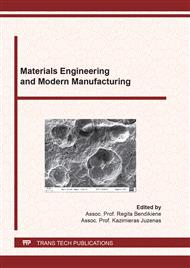p.113
p.119
p.126
p.131
p.139
p.144
p.150
p.155
p.161
The Influence of Heating Time on the Mechanical Properties of Laser Through-Transmission Welded Polyamide PPA40GF Joint
Abstract:
The goal of this work was to investigate effect of heating time during welding on mechanical properties of High Performance Polyamide thermoplastic composite material PPAGF40. Studies showed that welded joints with shorter heating time from 6.1 s to 6.7 s had a higher amount of pores and burn mark defects compared to the welded joints with longer heating time. Cross-section analysis of welded samples revealed tendency, that samples with higher heating time from 7.4 s to 11.5 s possessed more homogenous weld seam and higher resistance to burst pressure, respectively from 5.1 bar to 7.5 bar, while the resistance to pressure values of shortest heating time range, respectively are varying from 3.3 bar to 3.9 bar. The weld seam defects like pores and burn marks weakened the welded joint. 470 W of laser power energy input influenced fast melt-down of a cover and a housing, which caused material partial evaporation and later on formation of pores inside weld seam. By using lower 450 W of laser power and scanning speed of 1900 – 1700 mm/s, we can observe more homogenous weld seam. The cross-section of the samples were examined by using optical microscope. Mechanical resistance to pressure was performed in order to evaluate the performance of welded joints of different heating time of PPAGF40.
Info:
Periodical:
Pages:
139-143
Citation:
Online since:
June 2021
Authors:
Price:
Сopyright:
© 2021 Trans Tech Publications Ltd. All Rights Reserved
Share:
Citation:


